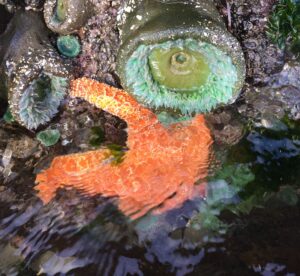
To us overly speedy humans, sea stars my look merely pretty and slow, but in their habitat, intertidal and sub-tidal shorelines, starfish are the terror of the neighborhood, an apex predator.

The largest starfish in the world and perhaps the fastest is the Sunflower star. This is the Tyranosaurus Rex of the intertidal zone, having between 16 and 26 legs that spread up to a meter wide and running down hapless mollusks at a top speed of 3 feet per second.
I remember wading along a shallow bay entrance on Cortez Island in British Columbia in the 1980’s, walking along the backs of sunflower sea stars .The sunflower star is extremely common from Calfornia to Alaska.
Or rather it was common. In 2013 a wasting disease called Sea Star Wasting Syndrome wiped out the majority of the sea stars along the entire West Coast of the US and Canada. Divers up and down the coast watch sea stars disintegrate into slime in huge numbers. Sunflower stars were hit the hardest and have not been able to recover; they are now very rare. The disappearance of the sunflower sea star is causing huge effects in the intertidal habitats because they are a keystone predator. If fact the ecological phrase keystone predator was invented about starfish.
Back in 1963 an influential ecologist named Robert Paine performed a famous experiment. He found a rocky shore in Makah Bay on the Olympic Peninsula with diverse intertidal life where ochre starfish were the top predator. If you’ve looked at west coast tide pools, you’ve seen these purple or orange guys.

Using a crowbar he pried every ochre sea star off the rock and threw it as far into the sea as he could. Twice a month he removed all the ochre starfish. Soon two species, goose barnacles and mussels had crowded out most of the other animals and 7 out of the 15 animals of the habitat had disappeared completely.
Robert Paine postulated that the ochre starfish was a “keystone predator”, their absence rippled outward, remaking their environment. Paine called these ripples “trophic cascades” and as he and many other biologist performed follow-up experiments in many ecosystems that confirmed the findings, these words became standard biological principles. There were ecological rules that governed populations.
The die-off of sea stars is being called “the largest wildlife die off in recorded history” by at least one marine science observer. That may be an exaggeration but the disappearance of a major predator along the entire west coast of North America is huge. The disappearance of sunflower stars in particular is having big trophic cascades.
On much of the west coast, sunflower stars are the main predator of green sea urchins. Where the sunflowers stars are disappearing, armies of green urchins are wiping out the kelp, creating sea urchin barrens. Kelp are the forest of the underwater shallows on the West Coast, the bottom of the food chain and the provider of shelter for many organisms. Disappearance of kelp forests appear to be worse in areas where the other great predator of sea urchins, sea otters, have already disappeared. I’m looking at you, Oregon and Washington shoreline.
What has caused the sea star die off? A virus, sea-star-associated densovirus, or SSaDV seems to be the likely culprit in many species but not all. There is evidence that in British Columbia at least, outbreaks are associated with areas of warming water. The die-off coincided with the appearance of the “blob” of much warmer then usual water off the shores of British Columbia and the Northwest USA. Most marine scientists believe the outbreaks are related to ocean warming, but not all the evidence is clear. As is the norm in ocean ecology, we don’t know very much.
Humans suffer from ocean blindness. We don’t live in the oceans; we can’t see marine habitats and they are expensive to study. We don’t see changes in ocean habitats until they become enormous. We are killing off marine habitats faster then we are learning about them.
